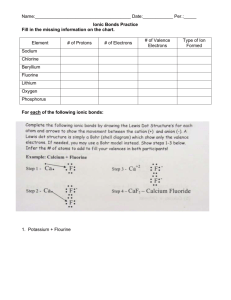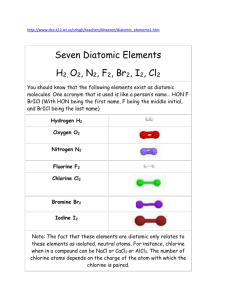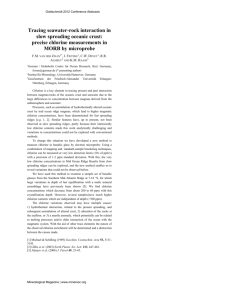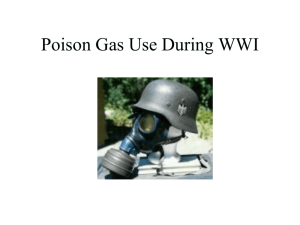E-5, Sector, Paryawaran Parisar, FAX : +91 (755) 2463 742
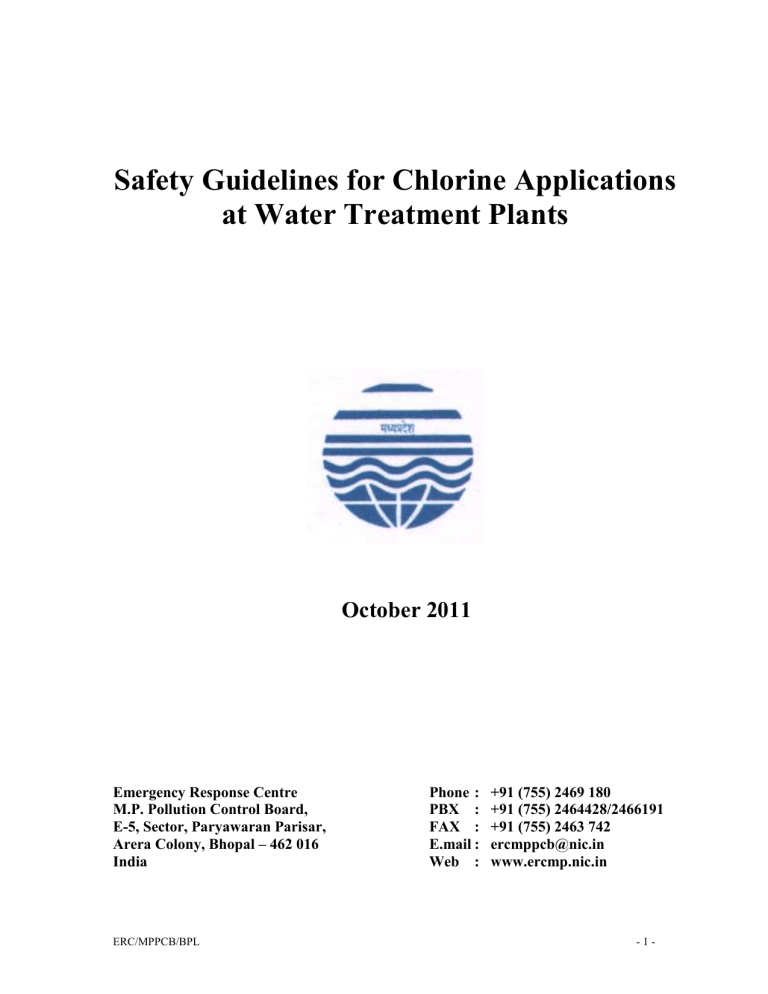
Safety Guidelines for Chlorine Applications at Water Treatment Plants
October 2011
Emergency Response Centre
M.P. Pollution Control Board,
E-5, Sector, Paryawaran Parisar,
Arera Colony, Bhopal – 462 016
India
Phone : +91 (755) 2469 180
PBX : +91 (755) 2464428/2466191
FAX : +91 (755) 2463 742
E.mail : ercmppcb@nic.in
Web : www.ercmp.nic.in
ERC/MPPCB/BPL - 1 -
INDEX
1.
2.
3.
Introduction
Application of Disinfectant at Water Works
Characteristics of Chlorine
4.
5.
6.
7.
8.
Exposure Routes
Exposure Limits
Harmful Effects of Chlorine
Causes of Concern for Chlorine Application
04
04
04
05
Requirement of Safety Systems at Water Treatment Plant 06
9. Storage and Handling of Chlorine Cylinders 09
09 10. Chlorine Detection and Decontamination System
10.1 Detection System
10.2
10.3
Neutralization Pit
Scrubber System
11. Spill & Leakage Handling
12. Personal Protective Methods
13. First Aid
14. Appendices i. Abbreviations used
09
10
12
13
14
16
14
17
03
03
03
ERC/MPPCB/BPL - 2 -
1. Introduction :
Chlorine is one of the most common chemicals used in diverse industrial fields including pharmaceuticals, pulp & paper industries, automobile components manufacture, agrochemicals and in manufacturing products of domestic and other use like cleaning & bleaching agent, PVC etc. Chlorine is widely used in treatment of water as disinfectant and protection against waterborne microbes.
Chlorine is hazardous and may pose potential risk and a severe emergency may suddenly and unexpectedly occur at chlorine storage and handling site. Such eventualities should be anticipated and proper system must be installed to tackle them effectively.
2. Application of Disinfectants at Water Works :
A wide range of disinfectants are available such as chlorination, ozonization and
UV disinfection and all water works use them for the supply of safe potable water. Despite being toxic, the chlorine is the most preferred disinfectant on account of lower cost and easy availability.
3. Characteristics of Chlorine :
Chlorine gas is 2.48 times heavier than air and is greenish yellow in colour with disagreeable, sharp, pungent and penetrating odor. It is non flammable but strong oxidizer and highly corrosive, very toxic to aquatic organisms and birds. It can exists as a gas or as a liquid. The liquid chlorine is amber coloured and about
1.44 times heavier than water. It vaporizes at standard temperature and pressure with 1 litre liquid yielding about 450 litres of gas.
Conversion – 1 ppm = 2.89 mg/m 3
Solubility in water – 0.7%
Freezing Point – -150 o F
Vapor density – 2.48 g/litre
Vapor pressure – 5.8 bar at 20 o
C
Sp. Gravity – 1.47 g/ml at 0 o C
Critical Temp. – 144 o C
Critical pressure – 76.1 atm (7711 kPa)
Viscosity – 0.346 centipoise at 0 o C (liq)- 0.0134 centipoise at 0 o C (gas)
ERC/MPPCB/BPL - 3 -
4. Exposure Routes :
The chlorine enters the body through Skin, Eyes and Inhalation.
5. Exposure Limits :
OSHA PEL (TLV) - 1 PPM (2.89 mg/m 3 )
IDLH - 10 PPM
TWA limit - 1 PPM (For skin)
(8 hours exposure)
NIOSH-REL 0.5 PPM (1.45 mg/m3)
(15 minutes exposure)
6. Harmful Effects of Chlorine:
Chlorine in high concentration acts as an asphyxiant by causing cramps in the muscles of the larynx (choking), swelling of the mucous membranes, nausea, vomiting and anxiety. Acute respiratory distress including cough, hemoptysis, chest pain, dyspnea, and later tracheobronchitis, pulmonary edema, and pneumonia may supervene (see table below).
430 ppm
1000 ppm or more
Toxic Effects of Chlorine
Effects Chlorine Concentration
0.03 - 0.1 ppm
1 - 3 ppm
3 - 5 ppm
5 - 15 ppm
10 ppm
30 - 60 ppm
Range of odour threshold
May cause mild irritation to eyes, nose, throat
Stinging or burning in eyes, nose, throat. May cause headache, watering eyes, sneezing, coughing, breathing difficulty, bloody nose and blood-tinged sputum.
Severe irritation of eyes, nose, throat and respiratory tract
Immediately Dangerous to Life & Health (IDLH)
Immediate breathing difficulty resulting in pulmonary edema, possibly causing suffocation and death.
Lethal after 30 minutes.
Fatal after a few breathes
ERC/MPPCB/BPL - 4 -
Chlorine is corrosive to the eyes, skin, and respiratory tract. Eye contact can cause permanent damage. Inhalation of the gas can cause pulmonary edema, a medical emergency that can be delayed for several hours. This can cause death.
Rapid evaporation of the liquid may cause frostbite. Repeated exposure may permanently damage the lungs or cause chronic bronchitis. Chlorine may affect the teeth resulting in erosion, and cause skin rash. A single high exposure may cause similar health effects.
7. Causes of concern for Chlorine Applications:
The use of chlorine for the disinfection of potable water supplies has been of great significance from a public health perspective but its application raises serious concerns which need prime attention from safety point of view. The causes of concern are as follows :
1. Chlorine is a highly toxic substance that is transported by trucks/road transport and can pose severe hazard in case of accident.
2. Chlorine is highly toxic, corrosive and penetrating at ambient temperature which poses potential health risk to staff at water treatment plant and general public around, if released by accident.
3. Stringent provisions for containment and neutralization needs to be maintained at chlorine storage and handling site at water works.
Chlorination Mechanism Chlorine tonners & Cylinders
ERC/MPPCB/BPL - 5 -
8. Requirement of Safety Systems at Water Treatment Plant :
All such installations must have written safe work procedures, but not limited to, for the following :
Cylinder change
Leak detection & control
Use of repair kit and container repair
Checking protocol
Respiration protocol
Self breathing apparatus protocol
Disposal of damaged containers
Routine maintenance of equipment
All the water treatment plants that have chlorination system and use chlorine for disinfection should have following safety arrangements in place to meet the emergency situation :
1.
2.
3.
4.
5.
6.
7.
8.
On-site Emergency Plan
Breathing apparatus
Emergency kit
Leak detectors
Neutralization tank
Scrubber system
Siren system.
Communication system.
9. Tagging system for equipments
10. First aid including tablets and cough mixtures
11. Exhaust fans
12. Facility for testing of pressure vessels, chlorine lines etc.
13. Training & mock drill
14. Safety showers & Eye fountain
15. Water curtain around storage facility
16. Protecting hoods for ton-containers.
17. Fire extinguishers.
18. Wind cock
19. Placards in local language for public cautioning, first aid and list of different authorities with phone numbers.
20. Personal protective equipments, viz. protective glass, clothings, gloves, shoes, helmet, goggles etc.
21. Placards at strategic locations showing Material Safety Data Sheet
(MSDS), International Chemical Safety Card (ICSC) etc. of chlorine.
ERC/MPPCB/BPL - 6 -
9. Storage & Handling of Chlorine Cylinders :
The chlorine has a great potential for creating hazard hence there is need to observe certain precautions for the storage, use and handling of chlorine cylinders at site. Some of the measures, that need to be observed in this regard, are given as follows :
Do not store the cylinders in exits or egress routes.
Cylinder storage area should be well ventilated.
Cylinders should not be stored in damp areas, near salt or corrosive
chemicals, fumes, heat or where exposed to the weather.
Cylinders should be stored in an upright position.
Always use proper trunnians to place a cylinder on ground.
Cylinders shall be secured with a chain or appropriate belt above the midpoint, but below the shoulder.
They must be stored in such a way that cylinders are used in the order in which they are received.
Avoid storing cylinder longer than one year without use.
Cylinders shall be kept at least 20 ft. away from all flammable, combustible or incompatible substances.
ERC/MPPCB/BPL - 7 -
Storage areas that have a noncombustible wall at least 5 ft. in height and with a fire resistance rating of at least 30 minutes may be used to segregate gases of different hazard classes in close proximity to each other.
Cylinders should not be dragged, rolled or physically carried. A lifter, hand truck, monorail etc. should be used to carry or transport the cylinder in the premises.
Magnets should not be used for lifting cylinders.
The cylinders should not be painted by users.
Close valves on gas cylinders when the system is not in use.
Do not open the cylinder if the valve is corroded.
ERC/MPPCB/BPL - 8 -
Check equipment and lines frequently owing to the corrosive nature of chlorine.
Never attempt to modify, alter or repair containers & valves. These tasks should be carried out by the suppliers.
Remove regulator after use and flush with dry air or nitrogen.
Only the wrenches and tools provided by the cylinder supplier should be used to handle the valve. Pliers or other tools should never be used instead.
Never attempt to apply PTFE tape or other sealing material to tight the seal.
The tightening should be achieved metal to metal else the valve or regulator should be replaced.
Never use oil or grease on the regulator of a cylinder valve.
An operator must be given proper training to handle the cylinder.
Always follow the chlorine suppliers' recommendations to dispose off leaking or damaged cylinders.
10. Chlorine Detection and Decontamination System :
10.1 Detection System
Chlorine detection and neutralization facility is essentially required at water treatment plants where chlorine cylinders or tonners are used for disinfection purpose. This system activates the emergency services and decontaminates the spilled material to tackle the chemical emergency situation.
The chlorine detection equipment should be installed at strategic locations in the plant area, including at chlorine injection area, cylinders storage area, cylinder off-load site etc, so that it can sense the odor even at 0.1 ppm ( 0.289 mg/m 3 ) and activate the siren to alert the people in and around. The chlorine detection systems should function in on-line as well as off-line mode, i.e. in the event of leakage when the chlorination is in progress, i.e. tonners in use, and also when the chlorination process is off or tonners are kept off line.
ERC/MPPCB/BPL - 9 -
In addition to gas detection equipment, ammonia torch test should be performed periodically at strategic locations in the plant area to check the chlorine leakage.
Silver nitrate test can also be tried to check the presence of chlorine, but the former should be preferred. Handy electronic detectors can also be used to check the leakage of chlorine.
Ammonia torch test Electronic detectors
Ammonia torch Test : A glass rod having cotton wrapper on one end, dipped in liquor ammonia, gives white smoke of ammonium chloride when comes in contact with chlorine.
Silver nitrate Test : When a glass rod, dipped in silver nitrate solution, comes in contact with chlorine, a white precipitate is formed at its tip.
10.2 Neutralization Pit
The chlorine storage and handling area in a water treatment/purification plant must have chlorine neutralization facility, viz. neutralization pit as well as scrubber system. The neutralization pit should be constructed close to chlorination site and chlorine storage area. There should be sufficient slope between platform and neutralization pit so that the leaked or defected chlorine cylinder/tonner can be rolled down easily and swiftly into the neutralization pit.
ERC/MPPCB/BPL - 10 -
The surface area and the volume of pit should be planned in such a manner that chlorine container is immersed completely in the alkali solution.
The caustic solution, sodium hydroxide, is preferred for the neutralization purpose owing to its faster and better absorption efficiency as against lime which cause problem of sludge formation and choking of treatment system pipelines. A ready prepared caustic solution should be used in the pit instead of pouring sodium hydroxide pallets in the pit water as the absorption efficiency in the later case would be less. Ideally the quantity of NaOH needed for the neutralizing one tonner, i.e. 900 kg, would be 1066 kg. The reaction between NaOH and Cl
2
goes as follows :
Cl
2
+ 2NaOH NaOCl + NaCl + H
2
O
70.9 + 80 74.5 + 58.5 + 18
Considering the stoichiometry and mass balance equation, 1 kg of Cl
2 and 1.3 kg of NaOH will produce 1.05 kg sodium hypochlorite, as evident from the above equation.
The other chemicals that can also be used for chlorine neutralization are as follows :
*
*
*
Potassium hydroxide
Sodium carbonate
Calcium hydroxide
*
*
*
*
Sodium sulphite
Sodium thiosulphite
Ferrous chloride
Hydrogen peroxide
The quantity of other chemicals required for neutralization of chlorine is given on the following page :
ERC/MPPCB/BPL - 11 -
Chlorine container capacity (Kg)
45
68
900
Caustic
Soda
Weight
(Kg)
58
Water
Volume
Soda
Ash
Ltr Weight
(Kg)
182 136
Water
Volume
Ltr
450
90
1160
270
3680
220
2720
680
9050
Hydrated
Lime
Weight
(Kg)
58
82
1160
Water
Volume
Ltr
566
815
11350
10.3 Scrubber Unit
In addition to chlorine neutralization pit, all the water treatment plants should have an effective automated chlorine scrubber system which can activate automatically immediately on sensing the chlorine presence in the ambient environment to absorb the leaked gas and neutralize it in the scrubber.
The Chlorine Gas Leakage Detection, Absorption and Neutralization System reduces the risk of chlorine gas spreading into the atmosphere. It automatically controls and absorbs heavy leaks from 100 kg or from 900 kg ton containers to absorb in caustic solution, thus forming hypo chlorite that can be reused as a cleaning agent.
ERC/MPPCB/BPL - 12 -
The scrubber/neutralization system consists of a blower, absorption tower packed with rasching rings, an alkali (NaOH) tank, alkali circulation pump, piping valves and light weight FRP and PVC duct. The chlorine gas is sucked by blower and is delivered to the absorption tower where it is absorbed by absorbent and the air is vented at the top of the tower. As the extracted air, contaminated with chlorine gas, is blown up through the column the caustic soda reacts with it to form sodium chloride and sodium hypochlorite. As this absorption is accompanied by a chemical reaction, there is negligible chlorine in the air vent.
It should be ensured that a sufficient quantity of absorbent is continuously circulated in the absorption tower from the absorbent tank till the tonner gets emptied. The spent absorbent, after completion of neutralization of all chlorine, will contain only sodium chloride or sodium hypochlorite which are innocuous.
11. Spill / leakage handling :
In the event of spillage or leakage of chlorine following measures may be observed for speedy control and minimizing the extend of damage:
Contact Emergency Response Centre on phone no. 0755-2469180 (Direct),
2464428, 2466191 (PBX) or Fax no. 0755-2463742 and other concerned expert agencies for emergency support.
Evacuate danger area around the incident site. Evacuate and restrict persons not wearing protective equipment from area of spill or leak until cleanup is complete.
Stop or reduce leak if it is safe to do so and prevent chlorine from entering sewers, waterways or confined spaces.
Supply sufficient replacement air to make up for air removed by exhaust systems.
The person should wear protective gloves, protective clothing, safety goggles, breathing apparatus as specified in Section 11.
If the gas is leaked, stop the flow of gas if it can be done safely. If the source of the leak is a cylinder and the leak cannot be stopped in place, remove the leaking cylinder to a safe place in the open air, and, repair the leak, if possible, using a standard kit.
ERC/MPPCB/BPL - 13 -
If the leak can be stopped in place, bubble chlorine left in the service line through a sodium sulfide and excess sodium bicarbonate solution with the help of a trap in the line.
Follow the neutralization process as stated in Section 10.3. If the scrubber system fails to operate, follow the process as per Section 10.2.
For liquid spills, ventilate area and wash down spill with water.
12. Personal Protective Measures :
There is always chance of leakage or spillage of chlorine gas at water treatment facility and there is likelihood of excessive gas levels in case the leaked gas is not controlled and this can adversely affect the plant staff and people in the vicinity area. It is, therefore, strongly recommended to have respiratory protection in the form of full-face gas masks with proper canisters or supplied air respirators (SAR) at site which can be used by the staff in times of emergency.
The skin effects of chlorine can generally be controlled by good personal hygiene practices. If very high gas concentrations or liquid chlorine is present, full protective clothing, gloves, and eye protection should be used. The following are recommended in this regard :
Butyl rubber, Neoprene, Teflon™, Saranex ™, Barricade ™, CPF3 ™,
Responder ™, Viton ™, Trellchem HPS ™, Tychem 10000 ™ (Resistance to breakthrough longer than 8 hour) are among the recommended protective materials.
Nitrile rubber, 4H ™ (Resistance to breakthrough longer than 4 hours) is also recommended.
It is not recommended to use very thin natural rubber, neoprene, nitrile and
PVC gloves of 0.3 mm or less.
Polyethylene and polyvinyl chloride are also not recommended.
ERC/MPPCB/BPL - 14 -
Use supplied air respirator (SAR) or chemical cartridge respirator with cartridge to protect against Cl
2
up to 5 ppm.
Personal Protective gadgets
Use SAR operated in a continuous flow mode with cartridge / full face piece chemical cartridge respirator with cartridge / gas mask with canister / full face piece self-contained breathing apparatus (SCBA) or full face piece SAR to protect against chlorine up to 10 ppm.
ERC/MPPCB/BPL - 15 -
13. First Aid :
In the event of an exposure to chlorine, the following first aid measures can be adopted to minimize the damage to body systems :
The aids that should be made available at chlorine storage and handling site for immediate assistance include Compressed oxygen, forced-oxygen mask, soap, water, normal saline, D5W, Ringer's lactate, isoproterenol inhaler, sodium bicarbonate etc.
D5W is 5% dextrose in water which consists of 278 mmol/L dextrose. Ringer's lactate is basically crystalloids which include saline and dextrose.
In case of skin exposure, remove the contaminated clothes immediately, rinse skin with plenty of water for at least 15 minutes and wash the skin with soap and water.
In case of exposure to eyes, rinse the eyes with plenty of lukewarm water for at least 15 minutes. Contact doctors for medical aid.
Do not allow the victim to drink alcohol or smoke.
Give plenty of milk to the victim, if he can drink.
In case of inhalation try to get fresh air or artificial respiration. Check respiratory rate and note any trauma. In case if no pulse is detected, provide cardiopulmonary resuscitation (CPR). If not breathing, provide artificial respiration. If breathing is labored, administer oxygen or respiratory support.
ERC/MPPCB/BPL - 16 -
Abbreviations Used
CPR - Cardiopulmonary Resuscitation
ERC - Emergency Response Centre
FRP - Fiber Reinforced Plastic
ICSC - International Chemical Safety Card
IDLH - Immediately Dangerous to Life & Health
MSDS - Material Safety Data Sheet mg/m 3 - Milligram per cubic meter
Mmol/L - Millimole per liter
NIOSH - National Institute of Occupational Safety & Health
PPM - Parts Per Million
PEL - Permissible Exposure Limit
PTFE - Polytetrafluoroethylene
REL - Recommended Exposure Limit
SAR - Supplied Air Respirator
SCBA - Self Contained Breathing Apparatus
TLV - Threshold Limit Value
TWA - Time Weightage Average
PVC - Polyvinyl Chloride
ERC/MPPCB/BPL - 17 -



